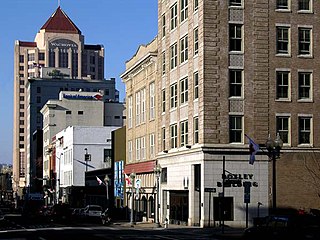
The Roanoke Downtown Historic District is a national historic district located in the Downtown Roanoke area of Roanoke, Virginia. It encompasses 122 contributing buildings. It includes a variety of commercial, institutional, social, and governmental buildings and structures from the late 19th century to the mid-20th century. Notable buildings include the Roanoke City Public Library, the YMCA Central Branch Building, First Christian Church (1925), the Central Church of the Brethren (1924), Tomnes Cawley Funeral Home (1928), Thomas B. Mason Building (1961), Peerless Candy Co., City Hall / Municipal Building (1915), Roanoke Times Building (1892), Anchor Building / Shenandoah Building (1910), Greene Memorial Methodist Church (1890), and United States Post Office and Courthouse (1930). Located in the district are the separately listed Patrick Henry Hotel, the Boxley Building, the Campbell Avenue Complex Historic District, Colonial National Bank, and First National Bank.

Roanoke City Market Historic District, also known as City Market District, is a national historic district located in the Downtown Roanoke area of Roanoke, Virginia.

St. Paul's Church is a historic Episcopal church in Lynchburg, Virginia, United States.

Brick House, also known as Garland House or King David's Palace, is a historic home located in the village of Clifford, Amherst County, Virginia. It is a two-story Federal Style, Flemish bond brick house with a projecting pavilion. It was built about 1803 by David Shepherd Garland, later a U.S. Congressman, and measures 65 feet by 44 feet. Two additions were made during the nineteenth century; the first, about 1830, behind the east parlor and the second, about 1850, was adjacent to the dining room and the first addition.

The Lexington Historic District is a national historic district located at Lexington, Virginia. It includes 11 contributing buildings on 600 acres (240 ha) and dates from 1823. It includes Greek Revival, Queen Anne, "Picturesque Cottage", and other architecture. Notable buildings include Washington Hall located on the campus of Washington and Lee University, the Virginia Military Institute, Court House, Presbyterian Manse, Halestones, and The Castle. Located in the district are the separately listed Alexander-Withrow House, Barracks, Virginia Military Institute, the Stonewall Jackson House, Lee Chapel, Lexington Presbyterian Church, Reid-White-Philbin House, and Stono.

Greenway Historic District is a national historic district located near Boyce, Clarke County, Virginia. It encompasses 432 contributing buildings, 23 contributing sites, and 35 contributing structures. The districts includes the agricultural landscape and architectural resources of an area distinctively rural that contains numerous large antebellum estates. The district contributing buildings are primarily farm and estate residences and their associated outbuildings. Other contributing buildings include three schools, five churches, two mills, a gas station, a restaurant, and a railroad station. The contributing structures are mostly corncribs and the contributing sites are mainly cemeteries and ruins of historic buildings. The district contains ten individual properties and two historic districts already listed on the Virginia Landmarks Register and National Register of Historic Places.

Delaplane Historic District is a national historic district located at Delaplane, Fauquier County, Virginia.

Orlean Historic District is a national historic district located at Orlean, Fauquier County, Virginia. It encompasses 51 contributing buildings and 2 contributing sites in the rural village of Orlean. The district includes commercial buildings, churches, a post office, a former school, and multiple residences and their ancillary outbuildings that date from the late 18th century to the mid-20th century. Notable buildings include the Orlean Farm House, Smith-Hinkley House, the Anderson-Rector House and Store, the Greek Revival style Thorpe-Cornwell House, Jeffries Store (1885), Orlean Methodist Church (1881-1883), Providence Baptist Church (1883), and Orlean post office building (1956).

Paris Historic District is a national historic district located at Paris, Fauquier County, Virginia. It encompasses 53 contributing resources in the rural village of Paris. The district includes primarily residences, although the district also includes some commercial buildings, churches, a former school, and a cemetery. Fifty-two of the 53 contributing resources are already listed as part of the Crooked Run Valley Rural Historic District. Notable buildings include "Wagoner's Stand", the Josiah Murray House, the William Peck House, Old Paris Meeting House, the Willis-Carr House, the former Rogers Store, and Trinity United Methodist Church (1892).

Gloucester County Courthouse Square Historic District is a national historic district located at Gloucester Courthouse, Gloucester County, Virginia. The district encompasses 17 contributing buildings including the Gloucester County government buildings and those structures bordering the square, housing private businesses, offices and residences. The courthouse was built about 1766, and is a one-story, "T"-shaped brick structure with a hipped roof. Other notable buildings include the Botetourt Hotel ; the Botetourt Lodge; W. C. Tucker's Department Store Building; S and S Hobbies; and the Kearn's Real Estate storage house.

Smithfield Historic District is a national historic district located at Smithfield, Isle of Wight County, Virginia. It encompasses 289 contributing buildings and 2 contributing structures in the historic downtown and surrounding residential areas of Smithfield. There are 211 houses, 37 commercial buildings, 1 warehouse, 4 churches, 10 barns, 1 smokehouse, 23 garages, 1 farm office, 1 colonial kitchen, and 2 corncrib structures. Notable buildings include the original county clerk's office (1799), county jail, Wentworth-Barrett House, Wentworth–Grinnan House, King-Atkinson House, Smith-Morrison House (1770s), Hayden Hall, Boykin House, Goodrich House (1886), Thomas House (1889), Smithfield Academy (1827), Christ Episcopal Church, and Hill Street Baptist Church (1923). Located in the district and separately listed are the Old Isle of Wight Courthouse, Smithfield Inn, Windsor Castle Farm, and P. D. Gwaltney Jr. House.

Fifeville and Tonsler Neighborhood Historic District is a national historic district located at Charlottesville, Virginia. The district encompasses 264 contributing buildings and 3 contributing sites in a predominantly African-American residential section of the city of Charlottesville. It was developed between 1890 and the 1930s and includes examples of the Bungalow and Gothic Revival styles. The oldest is dated to 1822. Located in the district are the separately listed Oak Lawn, Benjamin Tonsler House, Delevan Baptist Church, and Gardner-Mays Cottage.

The West Freemason Street Area Historic District is a national historic district located at Norfolk, Virginia. It encompasses 48 contributing buildings in a primarily residential section on the western edge of the center city of Norfolk. It developed between the late-18th and early-20th centuries and includes notable examples of the Federal, Greek Revival, and Late Victorian styles. Notable buildings include Kenmure House Glisson House, Whittle House, McCullough Row, and the Camp-Hubard house. Located in the district is the separately listed Allmand-Archer House.
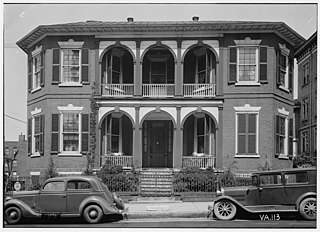
Hancock–Wirt–Caskie House, also known as The William Wirt House, is a historic home located in Richmond, Virginia. It was built in 1808–09, and is a two-story, seven-bay Federal-era brick dwelling with a hipped roof. The three bays on either side of the entrance are formed into octagonal-ended or three-sectioned bow front projections with a wooden, two-level porch arcade screening the central space. It has a central hall plan with an octagonal room on the south and a rectangular room behind and a larger single room across the hall. In 1816, William Wirt (1772–1834) purchased the house and lived there until 1818, when he moved to Washington as Attorney General of the United States under James Monroe. Formerly serving as the headquarters of the Richmond Chapter of the American Red Cross, the house is now a private residence. The last business to occupy this house was the law firm of Bowles and Bowles. The house bears a strong resemblance to Point of Honor in Lynchburg, Virginia.

The Two Hundred Block West Franklin Street Historic District is a national historic district located at Richmond, Virginia. It is located between downtown and the Fan district. The district encompasses 13 contributing buildings built during the 19th century and in a variety of popular architectural styles including Greek Revival, Federal, Beaux-Arts, and Queen Anne. Many of the dwellings have been converted to commercial use. Notable buildings include Queen Anne Row (1891), the Carter-Mayo House designed by Carrère and Hastings, the Cole Diggs House, the Smith-Palmer House, the Ida Schoolcraft House, the Price House, the A. S. Smith House, and the T. Seddon Bruce House.
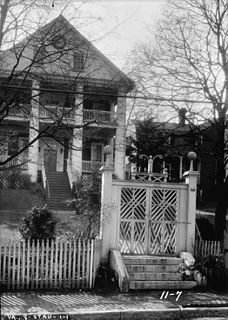
Stuart House is a historic home located at Staunton, Virginia. The original portion of the house was built in 1791, and is a story, temple-form brick structure fronted by a two-level pedimented portico supported by four very simple and provincial Tuscan order-like columns. The house measures 35 feet square, and is five bays wide and three bays deep. The house has a large 2+1⁄2-story brick wing added in 1844. The wing is fronted by a gallery ornamented with lattice-work and supported on brick piers. Also on the property is a gambrel roof frame building, erected sometime after 1783 as Archibald Stuart's residence and law office, and a pyramidal roof smokehouse. According to family tradition, Stuart received plans or suggestions for the house's design from his close friend, Thomas Jefferson. Archibald Stuart died in 1832 and the house was inherited by his son, Alexander Hugh Holmes Stuart (1807-1891).

Adam Kurtz House, also known as Washington's Headquarters, is a historic home located at Winchester, Virginia. It was built about 1755, and is of hewn-log construction. It consists of three rooms, with the westernmost room having two of its three exterior walls of stone construction. It sits on a rubble limestone foundation.
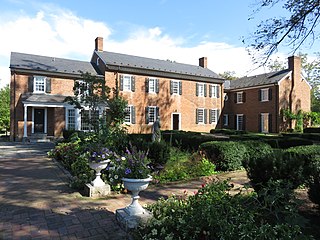
Glen Burnie is a historic home located at Winchester, Virginia. It consists of a 2+1⁄2-story central section built in two sections about 1794, with flanking two-bay, two-story wings built in 1959. It is a brick dwelling in the Georgian style.
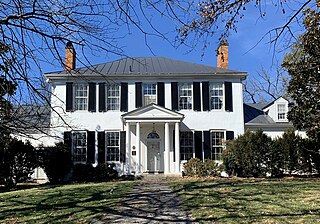
Fair Mount is a historic home located at Winchester, Virginia. It was built about 1809 by Lewis Barnett for local merchant Joseph Tidball. It is a two-story, five bay, stuccoed stone dwelling, with 1+1⁄2-story flanking wings. The house exhibits elements of the Late Georgian style in its massing and elements of the Federal style in its detailing. It was remodeled in 1929 in the Colonial Revival Style and the formal gardens and garage constructed.

Fincastle Historic District is a national historic district located at Fincastle, Botetourt County, Virginia. It encompasses nine contributing buildings in the central business district of Fincastle. The district resources portray an excellent example of a typical small 19th century town. The buildings include examples of Late Victorian, Greek Revival, and Gothic Revival styles. Notable buildings include the Botetourt County Courthouse and jail, Methodist Church, Presbyterian Church, St. Mark's Episcopal Church (1837), the Peck House, Selander House, Ammen House, and Kyle House (1832).
























